
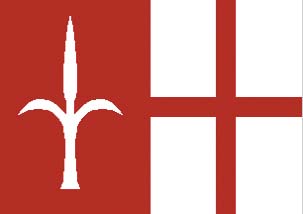 Lloyd Triestino was founded in 1919 and soon built up services to the Eastern Mediterranean, India, Australia, East Africa and the Far East. The twin funnelled liner Victoria of 13,098 grt was launched on 21st June 1931 at Trieste and when completed was the fastest motorship in the world at 23.25 knots. She was also unique in being the first passenger liner to have her Dining Room on ‘A’ Deck at the top of the accommodation, and she served on the East Mediterranean, Bombay and Far East routes. After the loss of almost all of their fleet during World War II, the company was able to resume passenger and cargo services to East Africa in 1948 with one ship calling at Mombasa, Dar es Salaam and Beira (Sofala). Their Australian service restarted on 19th October 1948 when the former Saarbrucken of NDL of Germany, one of three sisters built in 1923 of 9,442 grt, sailed as Toscana from Genoa to Melbourne and Sydney. She was an unusual looking liner as she had a corrugated hull with long side sponsons, and was joined on charter in 1949 by the Italia Line sisters Sebastiano Caboto and Ugolino Vivaldi of 9,744 grt.
Lloyd Triestino was founded in 1919 and soon built up services to the Eastern Mediterranean, India, Australia, East Africa and the Far East. The twin funnelled liner Victoria of 13,098 grt was launched on 21st June 1931 at Trieste and when completed was the fastest motorship in the world at 23.25 knots. She was also unique in being the first passenger liner to have her Dining Room on ‘A’ Deck at the top of the accommodation, and she served on the East Mediterranean, Bombay and Far East routes. After the loss of almost all of their fleet during World War II, the company was able to resume passenger and cargo services to East Africa in 1948 with one ship calling at Mombasa, Dar es Salaam and Beira (Sofala). Their Australian service restarted on 19th October 1948 when the former Saarbrucken of NDL of Germany, one of three sisters built in 1923 of 9,442 grt, sailed as Toscana from Genoa to Melbourne and Sydney. She was an unusual looking liner as she had a corrugated hull with long side sponsons, and was joined on charter in 1949 by the Italia Line sisters Sebastiano Caboto and Ugolino Vivaldi of 9,744 grt.
This Italia Line trio maintained the company service to Australia for the next two years until the company reputation for speed was restored with a new trio of 18.5 knot fast liners of 13,140 grt was completed with air conditioned accommodation for 719 passengers in three classes as Australia, Oceania and Neptunia. Toscana was then altered to carry 819 assisted migrants with no passengers paying full fare, and her homeward passage was cargo only, and she remained in service until her final sailing from Genoa to Australia on 18th August 1959. She was withdrawn from service and laid up in December, 1960 and arrived at a scrapyard in Genoa on 21st February 1962. The new trio of liners carried some assisted migrants in third class, and their forward well deck was plated over in 1959 to give a similar appearance to their four other sisters on the East African and Far East services. They reached Sydney from Italy after a voyage of 31 days, and an order was then placed for two flagships for the company for delivery in 1963 to cut the voyage time by eight days on the Australian service and they are the subject of this article.
Galileo Galilei
The order for these stylish sisters went to the Monfalcone yard of Cantieri Riuniti dell’ Adriatico (CRDA), with the keel of the first laid on 8th September 1960. In fact the sisters were built alongside each other with the yard using prefabrication techniques with blocks assembled together to form the hull for the first time. Galileo Galilei was launched on 2nd July 1961 as the first of the sisters, and was of 27,888 gross tons on dimensions of 702 feet by 94.2 feet and a fast service speed of 24 knots. She sailed on her maiden voyage from Genoa on 22nd April 1963 for Aden, Colombo, Singapore, Fremantle, Melbourne and Sydney, arriving after a voyage of 23 days with the homeward voyage via the Cape of Good Hope. She was a very elegant and stylish liner with a sharply raked bow, streamlined superstructure with a raked aluminium alloy navigation mast and a highly individualistic funnel with a steeply flared smoke deflector fin. She had been designed by Nicolo Constanzi, technical manager of CRDA, and her hull form had been tank tested and her funnel design had been wind tunnel tested by Carlo Mortarino of Turin Polytechnic.
The maximum number of passengers carried was 1,668 with 154 in First Class and 1,514 in Tourist Class, but the number of berths in the two classes could be varied according to the use made of blocks of interchangeable cabins – if these were used 289 First Class passengers and 1,358 Tourist Class passengers could be carried. ‘A’ Deck had almost all of the First Class cabins for single or double occupancy, but six de luxe cabins on Promenade Deck could be used for three persons as they had an additional removal upper berth. This sextet had divan beds and could be converted during the day into sitting rooms equipped with radio, television, bar and private bathroom. All of the First Class cabins had attractive pastel decoration with good use made of plastic for sound proofing of bulkheads and deckheads, with all of the First Class décor designed by a team of five Italian interior designers. The Promenade Deck was partly enclosed, and at the forward end of the superstructure the First Class Lounge and Ballroom, designed by Romano Boico, was very spacious. The Tourist Class accommodation consisted of two, three, four, six and eight berth cabins, and all passenger and crew cabins had thermostatic control of temperature, with the temperature of the Dining Room and other public rooms boosted by zone reheaters. The vessel was fully air conditioned, and maintained a temperature of 80 degrees Fahrenheit and a humidity of 55% in summer, and a temperature of 64 degrees Fahrenheit and a humidity of 55% in winter.
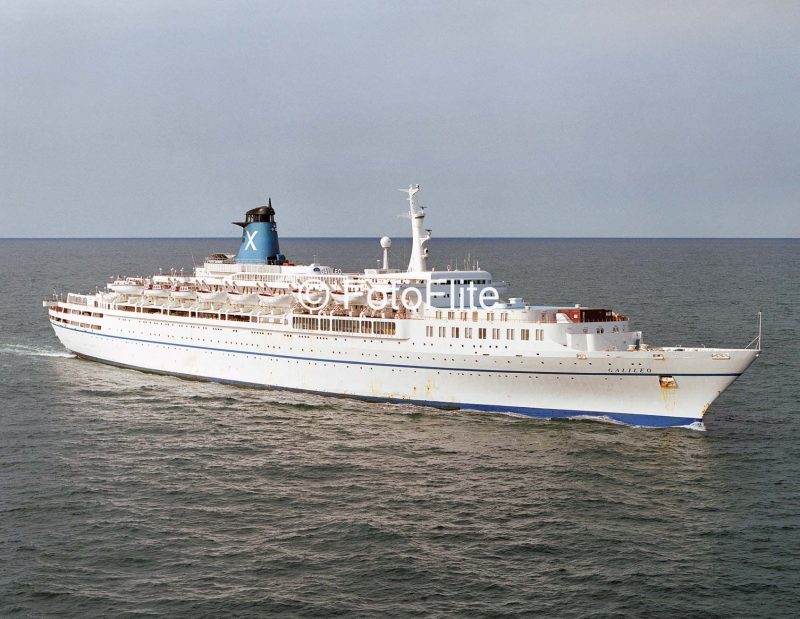
Galileo Galilei had two continuous steel decks with two more decks interrupted by engine room and boilers. She had a fo’c’stle of length 107 feet, a Bridge Deck of length 421 feet and an Upper Bridge Deck of length 383 feet. She was twin screw and powered by two Sta-Laval steam turbine sets developing a maximum continuous 44,000 shp at 144.5 rpm and manufactured by the builder at Trieste. A trials speed of 26.9 knots was attained, and fuel consumption at her service speed of 24 knots was 238 tonnes per day, with each turbine set consisting of one high pressure turbine and one low pressure turbine with an astern turbine incorporated in the low pressure turbine. Three Babcock & Wilcox superheat boilers produced steam for the main turbines, three turbo generators giving a total of 7,500 kilowatts, turbo feed pumps, air conditioning compressor, low pressure steam generator and other steam auxiliaries. Fuel oil capacity was 5,783 tons, sufficient to reach Australia, and the vessel could carry 9,480 tons of cargo with cargo handling by four derricks and four electric cranes and two conveyor belts for refrigerated cargo. She was fitted with MacGregor hatch covers, with two Magroside baggage loaders with a capacity of one tonne also supplied by Macgregor. She was divided into compartments by fireproof partitions, and her stair wells and lift shafts were lined with fireproof material. She was equipped with a Mather & Platt automatic sprinkler system plus an extensive network of fire hydrants.
Galileo Galilei made several voyages carrying assisted migrants to Australia during her first three years of service, and her sister Guglielmo Marconi made the last voyage carrying some migrants sponsored by the ICEM (Intergovernmental Committee for European Migration) amongst her other full fare paying passengers when she arrived in an Australian port on 30th March 1966. They always berthed with the assistance of tugs at Circular Quay at Sydney, passing the construction site of the Sydney Opera House during the last ten years of its construction until its opening in 1973. After the closure of the Suez Canal in 1967, the Australian service was routed via the Cape of Good Hope and homewards to Italy via the Pacific and was advertised as a ‘Round the World’ cruise. However, the Italian Government announced that all long distance Italian passenger services were to end in 1977, and Galileo Galilei completed her last Australian voyage in May 1977. Galileo Galilei and Guglielmo Marconi had been designed with cruising in mind, and they were then sent cruising for a public and private funded company named Italia Crociere Internazionali. Galileo Galilei was refitted at Palermo for Mediterranean cruising, and Guglielmo Marconi at Naples for Caribbean cruising. The latter ship began her cruises at New York on 27th December 1978 and was successful until July 1979 when the New York authorities announced her potable water chlorination system did not comply with current laws and she was laid up. Galileo Galilei had completed her Mediterranean series of cruises but her transfer to Florida for a series of Caribbean cruises was cancelled and she was laid up at Genoa on 6th September, 1980.
Guglielmo Marconi arrived at Genoa for lay up nine days later, and the two sisters were laid up side by side in Mediterranean style with sterns secured to the quay and both bow anchors down. They were a feature of Genoa harbour for a long period until they were both put up for sale in the summer of 1983. Galileo Galilei was then purchased by Celebrity Cruises owned by the Chandris family and became their cruise ship Galilei in 1984 under the Panamanian flag and then Meridian in 1990 after a refit with alterations in Germany. She was christened Meridian by Mrs Jeanne Chandris in February, 1990 and now had a total of 551 cabins (340 inside and 211 inside) with a total occupancy of 1,224 passengers. Her public rooms now included the Main Dining Room, Entertainments Lounge, Club Lounge, Bar discotheque, Piano bar, Buffet Restaurant, twin Garden Lounges for quiet reading, large casino, cinema as well as a gorgeous swimming pool. A long rear horizontal fin now projected from the top of her new blue funnel with a white central ‘X’ for Chandris.
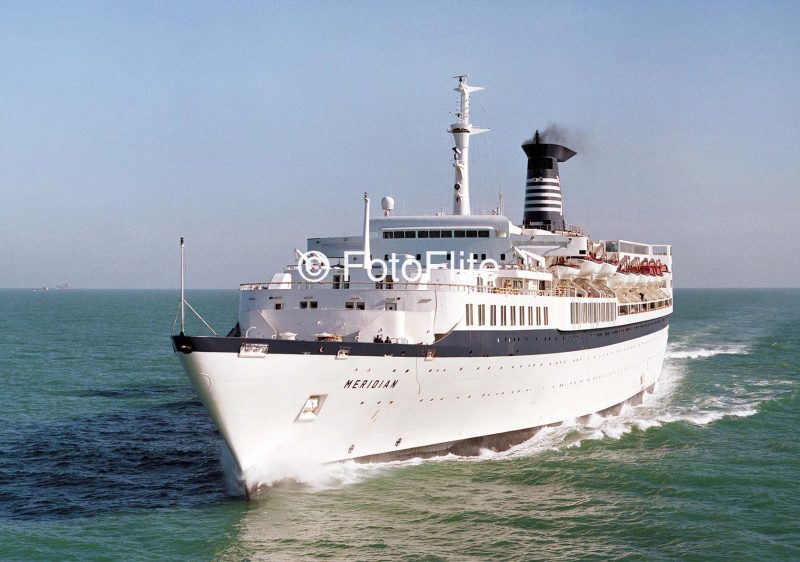
Meridian began to offer long two month cruises to South America and the South Pacific, visiting Fiji, Tonga, American Samoa, Tahiti, the Society Islands and Christmas Island, as well as circling the Pacific from Los Angeles to Hong Kong. Meridian also offered eleven day cruises to the Caribbean, and was sailing on seven day cruises from New York, Newport News (Va), Wilmington (NC), Charleston (SC) and Fort Lauderdale to King’s Wharf on Bermuda during April to August 1997. Meridian was then sold by Celebrity Cruises in late 1997 for $61.5 million to Metro Holdings, one of Singapore’s oldest retail companies, and operated by Sun Cruises. Royal Caribbean Cruise International (RCCI) had paid $515 million in July 1997 for Celebrity Cruises, although Celebrity Cruise ships kept their own separate identity and colours. John Chandris, the third generation of the family, and Morton Hyman of Overseas Shipholding Group (OSG) were appointed to the RCCI Board. Meridian was renamed Sun Vista and given a broad blue band at weather deck level, and a ‘golden sunset’ logo on her dark blue funnel. She then ran three cruises per week from Singapore to Bintan, Tioman, Malacca, Penang and Medan. Singaporeans typically do not plan their vacations more than three months in advance, and thus these short coastal cruises were popular.

However, on the afternoon of 20th May 1999, she was returning to Singapore after a cruise to Phuket when a malfunction in the engine room switchboard ignited a small fire. Despite fire fighting efforts by her crew, the fire could not be contained and spread rapidly throughout the ship with black smoke pouring out of her funnel. A Mayday call was sent out at 1830 hours, with all of her 472 passengers and 672 crew safely taking to the lifeboats, and five to eight hours later all were rescued by two container ships. She sank by the stern in a raging mass of flames at 0130 hours the next day some 60 nautical miles south of Penang and 50 nautical miles west of Port Weld in the Straits of Malacca. There were no fatalities with only a very few minor injuries reported.

Guglielmo Marconi
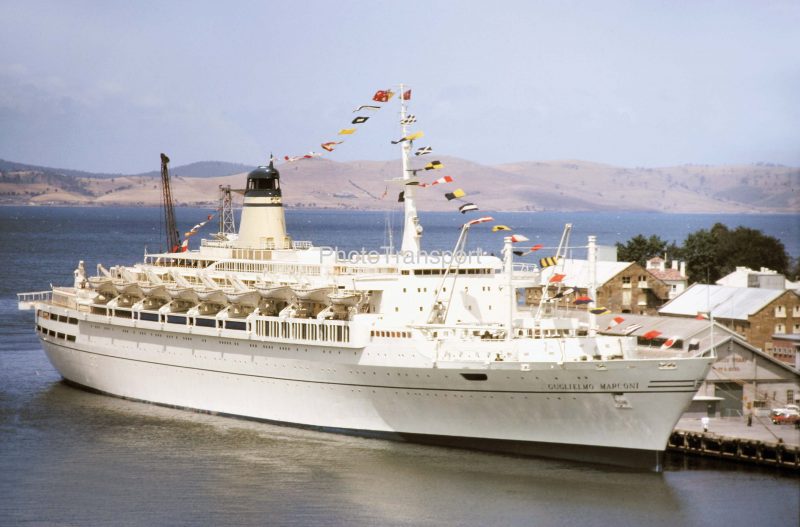
She was launched on 24th September 1961 by the wife of the famous radio pioneer and made her way out from her Venice dry dock to undergo trials on 20th October 1963, attaining a flat out speed of 26.78 knots She called at Trieste for the customary visit by the general public and sailed for Genoa on 23rd October and was officially handed over to Lloyd Triestino a week later. She sailed on a shakedown cruise in the Mediterranean on 9th November 1963 calling at Barcelona, Palma de Majorca and Malta. She then sailed on her maiden voyage to Australia on 18th November, 1963 calling at Port Said and passing through the Suez Canal, and then calling at Aden, Bombay, Singapore, Fremantle, Adelaide, Melbourne and Sydney, where she arrived on 11th December 1963. After the closure of the Suez Canal in June 1967, in company with her sister she sailed via the Cape of Good Hope to Australia, returning via the Pacific and the Panama Canal on a ‘Round the World’ type cruise. However, she was withdrawn from the Australian trade when she sailed for the last time from Sydney on 20th November 1975.
Guglielmo Marconi was then chartered to Italia Line for their South American service as a partner for their liner Cristoforo Colombo, sister of the ill fated Andrea Doria, and now repainted with a white hull. She sailed from Genoa to Rio de Janeiro and Buenos Aires for the first time on 30th December, 1975 and made her first entry into the Argentinean port on 18th January 1976. This service continued for another eighteen months until the Italian Government ended all long distance State owned passenger services, with Guglielmo Marconi arriving at Naples on 7th June 1977 and was laid up together with her sister. The sisters were then reactivated for cruising by a public and private funded company named Italia Crociere Internazionali, and as mentioned earlier this lasted for two years until both sisters were laid up again alongside each other.
Guglielmo Marconi was purchased by Costa Crociere on 22nd October 1983 and her name was painted out while plans were finalized for a complete reconstruction of the ship by the Mariotti yard in Genoa. This major rebuilding took two years to complete at a cost of $33.7 million with some funds coming from the Italian State for ship conversions carried out in Italian yards. Substantial prefabricated superstructure was added to both the fo’c’stle and stern, together with a new funnel, navigation mast and a forward leaning mast and crane at the open end of the new fo’c’stle superstructure. The vessel now had a completely different profile and accommodation for 974 passengers, and offered much open deck space for games and sunbathing. The new interior style of colours and decoration was very Italian and was designed for the enjoyment of large Italian families. A more economical service speed of 19 knots with derated engines reduced fuel consumption, but she still had reserves of power to reach a top speed of 22.5 knots.
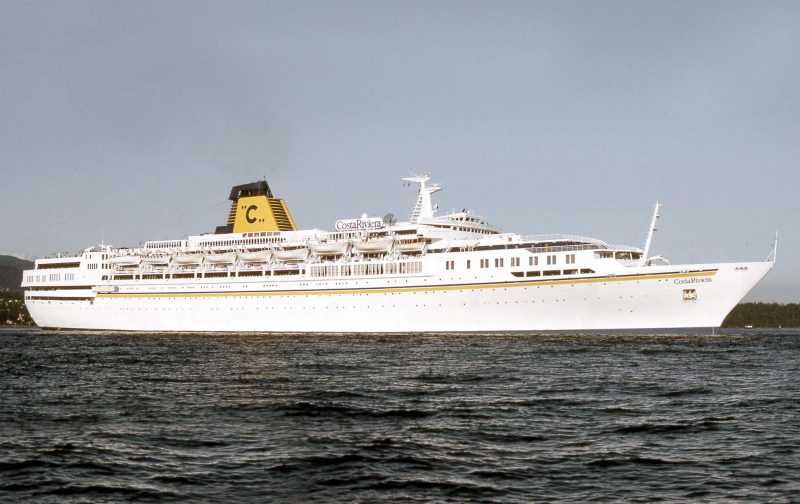
Guglielmo Marconi was renamed Costa Riviera and she sailed on her first Caribbean cruise from Fort Lauderdale on 14th December 1985, and for the next eight years cruised in summer from Vancouver to Alaska, and in winter from Fort Lauderdale to the Caribbean. New Costa Crociere cruise ships then entered service, and Costa Riviera was chartered to a new company called American Family Cruises, a joint venture between Costa Crociere and Bruce Nierenberg, one of the founders of Premier Cruise Line. She returned to Italy in September 1993 to undergo several modifications by the INMA yard at La Spezia at a cost of $25 million. She now had a total of 502 cabins (294 outside and 208 inside) with a total occupancy of 1,260 passengers, and her public rooms now included the Main Dining Room, Entertainments Lounge, two Club Lounges, Bar discotheque, Buffet Restaurant, Theatre as well as a large swimming pool. She was repainted with a dark blue hull bearing a large profile of an American eagle, and with ‘A’ for American Family Cruises on her funnel. She was renamed American Adventure by Ms Connie Stevens on 18th December 1993 at Fort Lauderdale and sailed at the end of the day on her first American Family Cruise to the Caribbean.
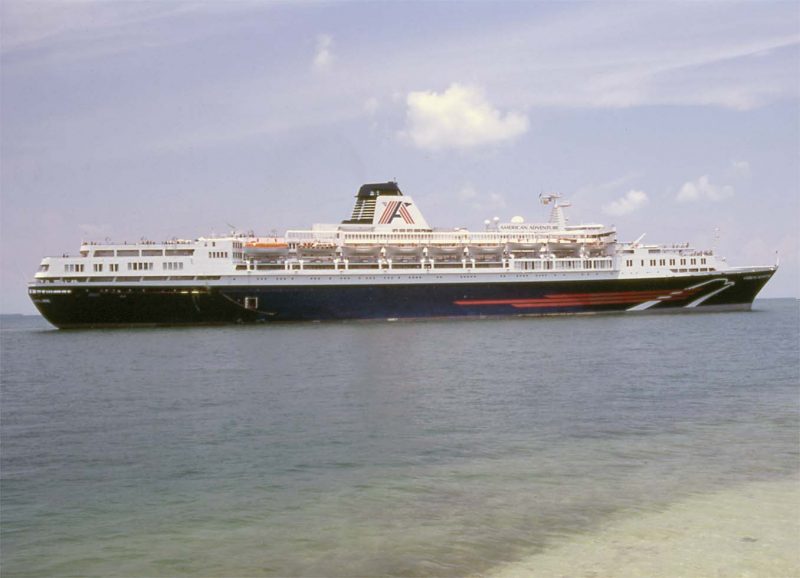
Unfortunately, American Family Cruises was a financial failure with very few passengers using this strikingly painted vessel, and she sailed from Fort Lauderdale on 10th September 1994 to return to Genoa to be repainted in Costa Crociere colours with thin blue and yellow hull stripes and regained her name of Costa Riviera. The first eleven day Costa cruise to the Atlantic Islands was from Genoa on 9th November 1994 for Malaga, Funchal, Santa Cruz de Tenerife, Lanzarote, Agadir, Casablanca and Barcelona. She then alternated for the next seven years between Atlantic Islands cruises and Western Mediterranean cruises from Genoa to Naples, Catania, Malaga, Almeria and Barcelona, or Eastern Mediterranean cruises to Naples, Catania, Alexandria, Port Said, Limassol, Ashdod, Rhodes, Kithera and Sorrento, or Black Sea cruises to Naples, Catania, Istanbul, Yalta, Odessa, Varna, Mykonos, Githion and Sorrento. Costa Riviera was withdrawn from service when Costa Europa, the former Westerdam, was transferred from Holland America Line in early 2002. She had suffered at the end of her 39 year career from bad cruise reviews on her ageing accommodation, dining room and poor entertainment. This must not detract in any way from her distinguished career as a stylish Italian liner to Australian and South American ports, or her later longer career as a cruise ship. She was sold for $1.7 million in February 2002 and arrived for breaking up at Alang in India under the name of Liberty.
Although this pair of stylish Italian liners were the first to be built at Monfalcone by prefabricated methods, this great shipyard thirty miles from Trieste has gone on to much greater things. As a member of the Fincantieri Group of eight shipyards in Italy, it completed over a dozen VLCCs and many Panamax bulkers, and now builds most of the giant megacruise ships that regularly sail off down the Adriatic on their maiden voyages to exotic cruise ports. Most of the giant Carnival Cruise Line cruise ships, and some of the Princess Cruises and Holland America Line cruise ships are some of the Monfalcone products in recent years.

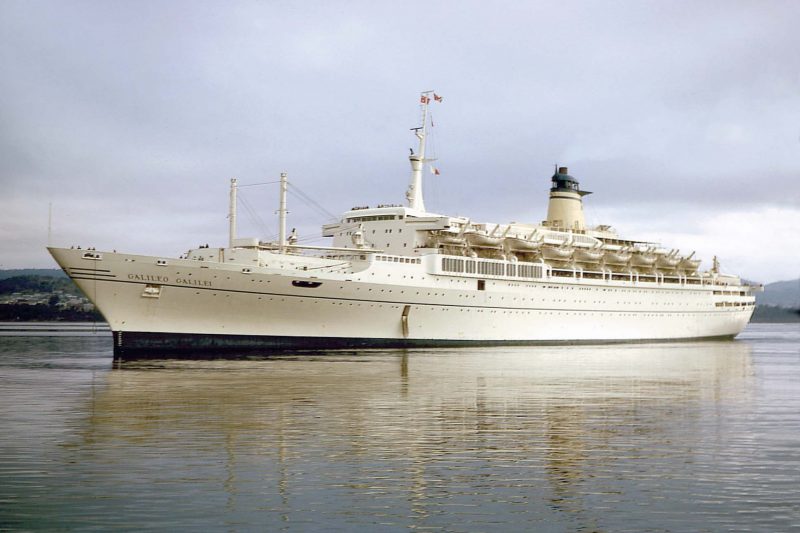
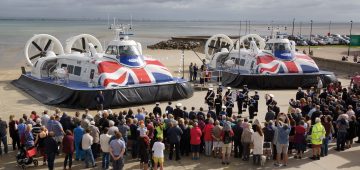



Comments
Sorry, comments are closed for this item